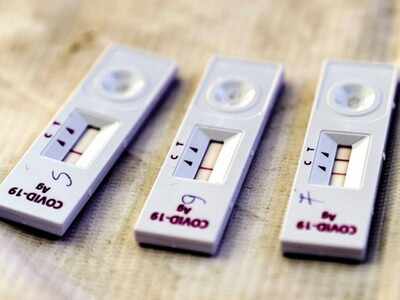- News
- City News
- lucknow News
- Lucknow records 3,000 plus cases for the 23rd day on a trot
Lucknow records 3,000 plus cases for the 23rd day on a trot

Image used for representational purpose only
LUCKNOW: If the first Covid-19 wave was a flood, the second is turning out to be a torrent.
The number of new Covid infections continued to be over 3,000 for the 23rd day in a row, and deaths over two dozen for the fifth consecutive day on Monday.
With this, the total case count in 14 months since the outbreak reached 2.1 lakh and toll to 1,883. However, of these, 62% (1.3 lakh) infections (1.3 lakh) and 37% (700) fatalities took place in just 48 days of the second wave so far.
“The novel coronavirus variant in the second wave seems to be highly transmissible, almost 20 times of the fist wave, resulting in the entire families and apartment buildings getting infected rapidly if anyone of the member or resident acquires infection from outside,” said an expert.
“However, a good sign was that daily cases and deaths were less on Monday as compared to Sunday. In fact, a slow decline in the daily infections and deaths has been witnessed in the past four days, he added.
Another encouraging sign was that the daily recoveries were more than new infections for the 12th consecutive day.
While the number of cases in 24 hours were 3,058 and deaths 26, about 5,686 patients also recovered in the same period. Overall, 95,426 patients who contracted infection during the second wave have recovered.
This also led to a drop in the number of patients with active cases to 3,6384 from Sunday's 3,9039. However, this has not reduced pressure from the hospitals because most of the recoveries are of asymptomatic or mild symptomatic patients recuperating in home isolation.
Since the recovery rate of hospitalised patients is low, the exponential surge has overwhelmed critical care services in the covid hospitals.
People are struggling to get an oxygen supported bed or an ICU for their critically ill family members in the hospitals, despite gradual increase in the number of beds by the district administration. Many families have made arrangements of oxygen for their patients at home.
Health officers said that at present, there are about 4,500 patients in the hospitals, of whom around 3,000 are serious or critical.
The number of new Covid infections continued to be over 3,000 for the 23rd day in a row, and deaths over two dozen for the fifth consecutive day on Monday.
With this, the total case count in 14 months since the outbreak reached 2.1 lakh and toll to 1,883. However, of these, 62% (1.3 lakh) infections (1.3 lakh) and 37% (700) fatalities took place in just 48 days of the second wave so far.
“The novel coronavirus variant in the second wave seems to be highly transmissible, almost 20 times of the fist wave, resulting in the entire families and apartment buildings getting infected rapidly if anyone of the member or resident acquires infection from outside,” said an expert.
“However, a good sign was that daily cases and deaths were less on Monday as compared to Sunday. In fact, a slow decline in the daily infections and deaths has been witnessed in the past four days, he added.
Another encouraging sign was that the daily recoveries were more than new infections for the 12th consecutive day.
While the number of cases in 24 hours were 3,058 and deaths 26, about 5,686 patients also recovered in the same period. Overall, 95,426 patients who contracted infection during the second wave have recovered.
This also led to a drop in the number of patients with active cases to 3,6384 from Sunday's 3,9039. However, this has not reduced pressure from the hospitals because most of the recoveries are of asymptomatic or mild symptomatic patients recuperating in home isolation.
Since the recovery rate of hospitalised patients is low, the exponential surge has overwhelmed critical care services in the covid hospitals.
People are struggling to get an oxygen supported bed or an ICU for their critically ill family members in the hospitals, despite gradual increase in the number of beds by the district administration. Many families have made arrangements of oxygen for their patients at home.
Health officers said that at present, there are about 4,500 patients in the hospitals, of whom around 3,000 are serious or critical.
FacebookTwitterLinkedinEMail
Start a Conversation
end of article
Trending Topics
Top Stories Right Now
- indiaSigns of Covid slowdown in Gujarat, Delhi, Maharashtra, Punjab, UP: Government
- indiaSupreme Court rejects EC plea to limit court reporting by media
- india11 killed in Bengal post-poll violence, Centre seeks report
- indiaSII, Bharat Biotech got advance of Rs 2,500cr for 16 crore doses: Govt
- indiaLive: New Covid cases may peak today, say experts
Quick Links
Delhi Air PollutionDelhi TemperatureChennai WeatherBangalore TemperatureCovid vaccination centres in DelhiCoronavirus in DelhiRTPCR test in GurgaonHyderabad RainPollution level in BangaloreDelhi SmogDelhi TemperatureNoida AQIGurgaon AQI todayFire in MumbaiMumbai RainsCovid 19 RT PCR Test in NoidaDelhi AQI todaySrinagar encounter